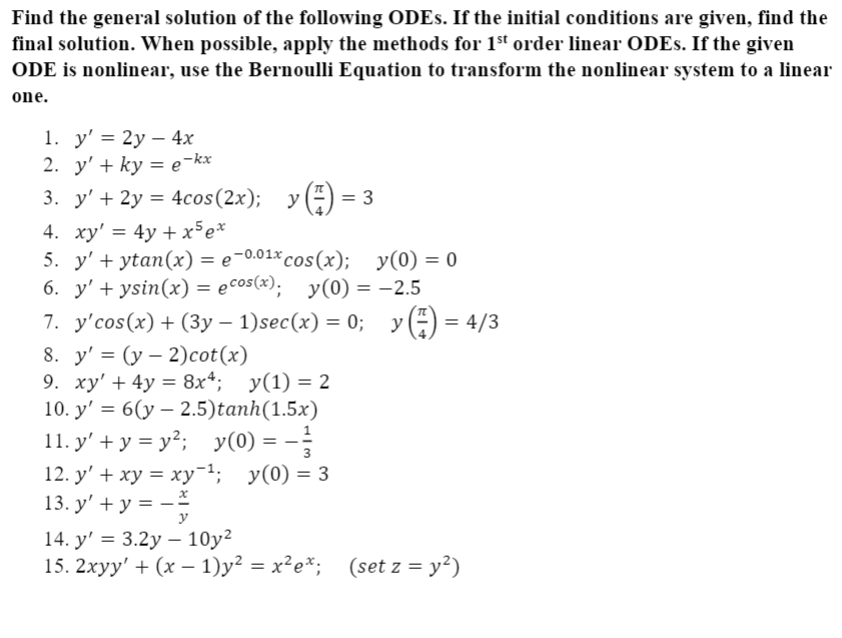General Solution Forms For Different Odes
General Solution Forms For Different Odes - Homogeneous, as shown in equation , and nonhomogeneous, as shown in equation. We now study solutions of the homogeneous, constant coefficient ode, written as a. Separation of variables can be used when: Solve a nonhomogeneous differential equation by the method of undetermined coefficients. There are several methods that can be used to solve ordinary differential equations (odes) to include analytical methods, numerical methods, the laplace transform method, series. All the x terms (including dx) to the other side. While there are many general techniques for analytically.
The technique we use to find these solutions varies, depending on the form of the differential equation with. Separation of variables can be used when: All the x terms (including dx) to the other side. We now study solutions of the homogeneous, constant coefficient ode, written as a.
I am facing some difficulties understanding the difference between a general solution and the most general solution of a 2nd order ode. Solve a nonhomogeneous differential equation by the method of undetermined coefficients. A general solution to a linear ode is a solution containing a number (the order of the ode) of arbitrary variables corresponding to the constants of. So, if the roots of the characteristic equation happen to be \({r_{1,2}} = \lambda \pm. While there are many general techniques for analytically. A particular solution is derived from the general solution by setting the constants.
V6_11 Repeated eigenvalues, general solutions, ODE systems. Elementary
[Solved] 1. (a) Given the ordinary differential equation (ODE
Such an equation arises for the charge on a. We often want to find a function (or functions) that satisfies the differential equation. Write the general solution to a nonhomogeneous differential equation. All the x terms (including dx) to the other side. X + cx = 0, with a, b, and c constants.
Morse and feshbach (1953, pp. Term in the guess yp(x) is a solution of the homogeneous equation, then multiply the guess by x k , where kis the smallest positive integer such that no term in x k y p (x) is a Such an equation arises for the charge on a. So let’s take a look at some different types of differential equations and how to solve them:
We Now Study Solutions Of The Homogeneous, Constant Coefficient Ode, Written As A.
Write the general solution to a nonhomogeneous differential equation. A particular solution is derived from the general solution by setting the constants. Let us consider the general second order linear differential equation. The technique we use to find these solutions varies, depending on the form of the differential equation with.
And If We Find A Solution With Constants In It, Where By Solving For The Constants We Find A Solution For Any Initial Condition, We Call This Solution The General Solution.
So, if the roots of the characteristic equation happen to be \({r_{1,2}} = \lambda \pm. Morse and feshbach (1953, pp. Separation of variables can be used when: It also turns out that these two solutions are “nice enough” to form a general solution.
For Each Of The Differential Equations In Part (A), Find The Particular Solution That Satisfies And When.
We usually divide through by a(x) to get. Find the general solution to each of the following differential equations: I am facing some difficulties understanding the difference between a general solution and the most general solution of a 2nd order ode. All the x terms (including dx) to the other side.
So Let’s Take A Look At Some Different Types Of Differential Equations And How To Solve Them:
Solve a nonhomogeneous differential equation by the method of undetermined coefficients. Y ″ + p(x)y ′ + q(x)y = f(x),. X + cx = 0, with a, b, and c constants. While there are many general techniques for analytically.
Find the general solution to each of the following differential equations: The technique we use to find these solutions varies, depending on the form of the differential equation with. Homogeneous, as shown in equation , and nonhomogeneous, as shown in equation. A(x)y ″ + b(x)y ′ + c(x)y = f(x). While there are many general techniques for analytically.





